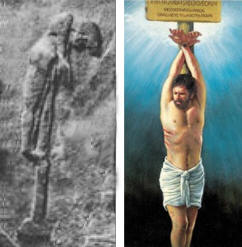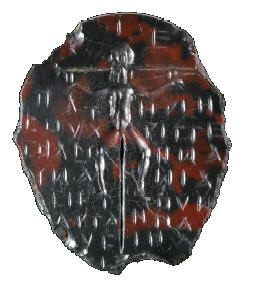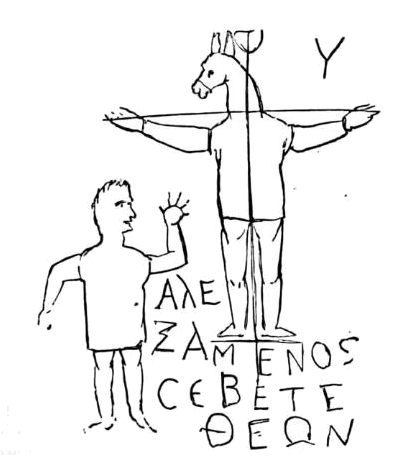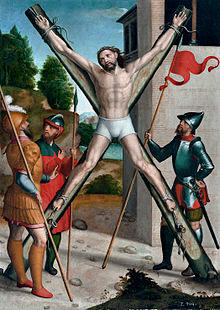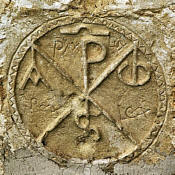-
Wooden crosses don't survive. They
all \degraded long ago or were
re-used
-
Victims of crucifixion were usually criminals and therefore not
formally buried, just exposed or thrown into a river or trash
heap. It's difficult to identify these bodies, and scavenging
animals would have done further damage to the bones.
-
Crucifixion nails were believed to have magical or medicinal
properties, so they were often taken from a victim. Without a
nail in place, it becomes more difficult to tell crucifixion
from animal scavengers' puncture marks.
-
For the most part, crucifixion involved soft tissue injuries
that can't be seen on bone. Only if a person had nails driven
through his bones would there be significant bony evidence of
the practice.
Today, the only evidence of Roman crucifixion we
have are the remains found in Jerusalem of a young man,
Yehohanon,
crucified in the first century A.D. The remains include a
heel bone pierced by a large nail, giving archaeologists,
osteologists and anthropologists evidence to work from.
The Romans apparently used several methods of crucifixion, but there
is almost no evidence of any kind to support the traditional method
we all see portrayed in church.
The Romans typically used one of these methods of crucifixion:
I
– Crux Simplex
Sometimes they used a single upright stake or post and either nailed
or tied their victim (in some cases this may have simply been to the
trunk of a tree).
Often they were impaled, as the ancient Assyrian image illustrates.
With this shape, the victim’s hands could be tied or nailed
quite simply with a single piece of rope or a single nail
Death could be relatively quick, within ten minutes, for those whose
hands were tied or nailed directly above their heads and whose feet
were restrained, too. A person crucified in this position would be
unable to exhale. This could not been the case with Jesus'
crucifixion since the Gospels say it took several hours for him to
die.
2 – Basic Cross
This shape is the traditional form Christians observe for the cross.
This cross was constructed from a vertical stake(called
a “stavros”) with a horizontal cross beam (called a
“patibulum”) inserted across it, leaving a “tip” extending above the
patibulum. Sometimes this tip was little more than a small
extension, resulting in a structure still resembling a “T” more than
a “+”. The patibulum was either fastened across the stake or
inserted down over the top of the stake. Victims were tied or nailed
to the structure with arms outstretched on either side of the
patibulum. Their feet were either nailed together or separately to
the bottom of the vertical post.
3 – St.
Andrew's Cross
This “X” shaped cross (also known as “St. Andrew’s Cross”) borrowed
its name from the Roman numeral ten (“decussis”). Two wooden planks
were fastened together in an X configuration and the victim’s were
nailed to the cross with arms outstretched on top ends of the X.
Their feet were either nailed or tied separately to the bottom ends
of the X.
That Jesus may have been crucified on
an X-shaped cross is a new idea arising from the studies of Joseph Zias. Eliezer Sekeles
and Hershel Shanks who examined the bone with a nail through it.
Their examinations and experiments suggested to them that he may
have been executed on an x-cross.
The nail from head to tip is
only 4.5 inches. I was held in place by a wooden plaque three
quarters of an inch thick that had been punctured by the nail before
it passed through the right heel bone. After exiting from the bone,
the nail penetrated the wood itself and then was bent to keep it
from being extrated. As the investigators observed, given the
length of the nail, “There simply was not enough room for both heel
and a two centimeter wooden plaque to have been pierced by the nail
and affixed to the vertical shaft of the cross" unless it were a
plank and not a pole.
Accordingly, the victim’s position on the cross must
have been different from that portrayed.
Wood was scarce and the Romans were
efficient. For this reason they used the X-cross. They simply
fastened to planks together in an X. Nailed the felon to it and left
him to slowly die. No pole in the ground was necessary. They cross
could be leaned against a wall or an all-ready-existing pole or
tree.
An argument used by supporters
of this idea is the fact the the oldest "cross symbol" used by the
Roman Catholic Church is the Chi-Rho. They
say that it represents Jesus onan X-cross - The Rho
being the body of Jesus on the Chi cross.
Many do not believe that Jesus
ever existed, let alone that he died on a cross.
Others do not care how he died. To
these the method of crucifixion are irrelevant.
But to others, true believers, if Jesus did not die on a cross as
taught in church, the Bible is wrong and the Christian religion is
just a fable!
For those seeking truth, the best evidence
is that crucifixion did not take place in the manner that
Christianity claims it did..
|

